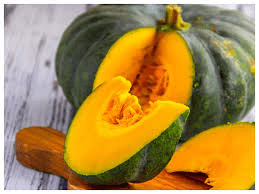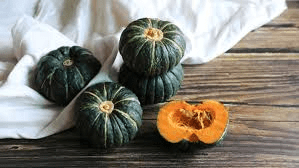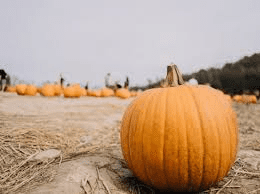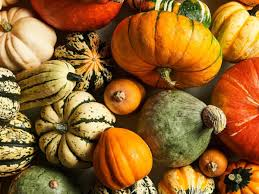Pumpkin fruits are fascinating members of the Cucurbitaceae family, known for their versatility, nutritional value, and rich cultural significance. These fruits, botanically classified as Cucurbita pepo, Cucurbita maxima, Cucurbita moschata, and Cucurbita argyrosperma, are native to North America and have been cultivated for thousands of years. Pumpkins are typically characterized by their round shape, ribbed skin, and vibrant orange color, though they can also be found in shades of white, yellow, green, and red.
The pumpkin’s anatomy is quite interesting, with a thick, hard outer rind that encases a dense, fibrous flesh. The flesh varies in texture and flavor, depending on the variety and maturity of the fruit. Within the flesh lies a cavity filled with seeds and stringy pulp. These seeds, also known as pepitas, are nutrient-dense and can be roasted for consumption. The entire pumpkin, including the flesh, seeds, and even the skin, is edible and packed with essential nutrients.
Pumpkin fruits are renowned for their high beta-carotene content, a precursor to vitamin A, which is vital for vision, immune function, and skin health. Additionally, pumpkins are rich in vitamins C and E, potassium, fiber, and antioxidants. This nutritional profile makes pumpkins an excellent food for promoting overall health and well-being. The high fiber content aids in digestion and helps maintain a healthy weight by promoting a feeling of fullness.
Cultivating pumpkins requires specific growing conditions. They thrive in warm climates with plenty of sunlight and well-drained, fertile soil. Pumpkin plants are typically grown from seeds, which are sown directly into the ground after the danger of frost has passed.
The plants require ample space to sprawl, as they produce long, trailing vines. Proper care involves regular watering, mulching, and pest control to ensure healthy growth and fruit production. Harvesting usually occurs in late summer to early autumn, once the pumpkins have reached their mature color and the rind has hardened.
In addition to their nutritional value, pumpkins hold significant cultural importance. In the United States, pumpkins are synonymous with autumn and are central to celebrations such as Halloween and Thanksgiving. Carving pumpkins into jack-o’-lanterns is a popular Halloween tradition, believed to ward off evil spirits. During Thanksgiving, pumpkin pie is a staple dessert, showcasing the fruit’s sweet and savory versatility.
Pumpkin fruits also play a role in various traditional and contemporary cuisines worldwide. In Latin America, they are used in dishes like soups and stews, while in Asia, pumpkins are incorporated into curries, stir-fries, and desserts. The seeds are often used as snacks or ingredients in sauces and garnishes. Beyond culinary uses, pumpkins have found their way into cosmetics, with pumpkin seed oil being a popular ingredient in skincare products due to its moisturizing and anti-inflammatory properties.
Moreover, pumpkins have ecological benefits. They contribute to sustainable agriculture by improving soil health through their extensive root systems, which help prevent soil erosion. Pumpkin plants also attract pollinators like bees, which are essential for the pollination of many crops.
Pumpkin fruits are not only a nutritious and versatile food source but also a symbol of cultural heritage and agricultural sustainability. Their rich history, diverse uses, and health benefits make them an integral part of various culinary traditions and farming practices. Whether used in a festive Halloween decoration, a hearty Thanksgiving pie, or a nourishing meal, pumpkins continue to captivate and nourish people around the world.
The Economic Importance and Uses of Pumpkin Fruits

1. Food Source: Pumpkins are a versatile food source, used in soups, pies, bread, and roasted dishes. For example, pumpkin soup is a popular dish in many countries.
2. Livestock Feed: Pumpkin seeds and flesh can be used as nutritious feed for livestock. For instance, pigs and chickens benefit from the high fiber content.
3. Seed Oil Production: Pumpkin seeds are pressed to produce oil, which is used for cooking and in salad dressings.
4. Medicinal Uses: Pumpkins have medicinal properties, such as pumpkin seed oil being used to support prostate health and improve bladder function.
5. Dietary Supplements: Pumpkin seeds are a rich source of zinc and magnesium, often used in dietary supplements.
6. Cosmetic Products: Pumpkin extracts are used in skincare products for their anti-aging properties. For example, pumpkin face masks help in exfoliation.
7. Pet Food: Pumpkin is a common ingredient in pet foods and treats, providing fiber and vitamins for pets.
8. Fertilizer: After pumpkins are processed, the remaining pulp can be composted to enrich soil quality.
9. Decorative Uses: Pumpkins are widely used for decoration, especially during Halloween as jack-o’-lanterns.
10. Biofuel: Pumpkin biomass can be converted into biofuel, contributing to renewable energy sources.
11. Economic Value in Tourism: Pumpkin festivals and farms attract tourists, boosting local economies. For instance, the annual pumpkin festival in Half Moon Bay, California.
12. Weight Loss Diets: Low in calories and high in fiber, pumpkins are often included in weight loss diets.
13. Anti-inflammatory Uses: Compounds in pumpkins have anti-inflammatory properties, which are beneficial in reducing arthritis symptoms.
14. Antioxidant Properties: Pumpkins are rich in antioxidants, which help in reducing oxidative stress and preventing chronic diseases.
15. Anti-parasitic: Pumpkin seeds have been traditionally used as a natural remedy for parasitic infections in humans and animals.
16. Business Ventures: Pumpkin farming and related products provide income for farmers and entrepreneurs.
17. Nutrient Cycling: Growing pumpkins helps in nutrient cycling and improving soil health in crop rotations.
18. Culinary Diversity: Pumpkin is used in diverse culinary traditions around the world, from Asian curries to American desserts.
Read Also: Honey Production Guide: The Basics to Get Started
The Products and By-products That Can Be Derived From Pumpkin Fruits

1. Pumpkin Puree: Made by cooking and blending pumpkin flesh, used in soups and desserts. Example: canned pumpkin puree.
2. Pumpkin Seeds: Harvested from the pumpkin, cleaned, and roasted as snacks. Example: roasted pumpkin seeds.
3. Pumpkin Seed Oil: Extracted by pressing the seeds, used for cooking and in cosmetics. Example: cold-pressed pumpkin seed oil.
4. Pumpkin Flour: Made by drying and grinding pumpkin flesh, used as a gluten-free flour substitute. Example: pumpkin flour for baking.
5. Pumpkin Juice: Extracted from the flesh, used as a beverage or in cooking. Example: fresh pumpkin juice.
6. Pumpkin Butter: A spread made from pumpkin puree, spices, and sweeteners. Example: spiced pumpkin butter.
7. Pumpkin Chips: Sliced and dehydrated or fried, served as a snack. Example: crunchy pumpkin chips.
8. Pumpkin Soup: Prepared by cooking pumpkin with broth and spices, often pureed. Example: creamy pumpkin soup.
9. Pumpkin Powder: Dried and ground pumpkin, used in supplements and cooking. Example: pumpkin powder for smoothies.
10. Pumpkin Vinegar: Produced from fermented pumpkin juice, used in dressings. Example: pumpkin vinegar for salads.
11. Pumpkin Enzyme Extract: Used in skincare for its exfoliating properties. Example: enzyme pumpkin facial masks.
12. Pumpkin Pickles: Pumpkin flesh pickled in vinegar and spices. Example: sweet and spicy pumpkin pickles.
13. Pumpkin Ale: Beer brewed with pumpkin and spices. Example: seasonal pumpkin ale.
14. Pumpkin Spice: A blend of spices used in pumpkin-flavored foods. Example: pumpkin spice latte mix.
15. Pumpkin Sweets: Candied pumpkin, often used in desserts. Example: pumpkin candy.
16. Pumpkin Bread: Bread made with pumpkin puree and spices. Example: pumpkin bread loaf.
17. Pumpkin Compost: Organic waste from pumpkin processing used as fertilizer. Example: compost from pumpkin skins and seeds.
Read Also: Facts About Honey Bees
Frequently Asked Questions (FAQ’s) About Pumpkin Fruits

1. What are the health benefits of pumpkin?
Pumpkins are rich in vitamins A, C, and E, antioxidants, and fiber, which promote good health and can help prevent chronic diseases.
2. Can pumpkin seeds be eaten raw?
Yes, pumpkin seeds can be eaten raw, though they are often roasted to enhance flavor and texture.
3. Is pumpkin a fruit or a vegetable?
Botanically, pumpkin is a fruit because it contains seeds, but it is often treated as a vegetable in culinary contexts.
4. How do you store pumpkin seeds?
Store pumpkin seeds in an airtight container in a cool, dry place, or refrigerate them to extend shelf life.
5. Can pumpkins be grown in containers?
Yes, small pumpkin varieties can be grown in large containers with proper care and support.
6. Are there different types of pumpkins?
Yes, there are many varieties, including sugar pumpkins, which are good for cooking, and large jack-o’-lantern types for carving.
7. How do you make pumpkin puree at home?
Bake or steam the pumpkin until soft, then blend the flesh until smooth to make homemade pumpkin puree.
8. What is the best way to preserve pumpkins?
Pumpkins can be preserved by canning, freezing, or drying, depending on the intended use.
9. Can pumpkin be used in savory dishes?
Yes, pumpkin is versatile and can be used in soups, stews, and savory pies, not just sweet dishes.
10. How long does it take for pumpkins to grow?
Pumpkins typically take 90 to 120 days to mature from planting to harvest, depending on the variety.
Read Also: Financial Projections for Waste Management Business

